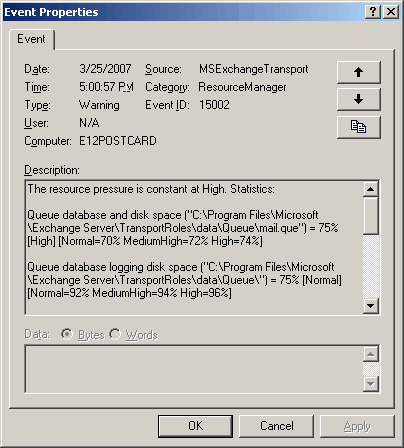Exchange Server 2007 Transport: 452 4.3.1 Insufficient system resources
In my hotel room in Orlando, getting ready for a presentation tomorrow morning at TechMentor. When trying to telnet to the SMTP port of an Exchange Server 2007 Hub Transport server, I got the following error:
452 4.3.1 Insufficient system resources
Not a good thing the night before a presentation – Murphy’s law at work again!
The Application Event Log has Event ID 15002 from MSExchangeTransport saying “The resource pressure is constant at High. Statistics… “. The event goes on to tell you thatinbound mail submission has stopped, and it’s due to disk space being low on the volume where the queue database is located.

Figure 1: Event ID 15002 logged by MSExchangeTransport

Figure 1: Event ID 15002 logged by MSExchangeTransport
Exchange Server 2007 transport queues are not the familiar .eml files you see in Exchange Server 2003/2000, which reside in the \mailroot\vsi <1>\queue folder (<1> is the instance number of the SMTP virtual server) on the file system. Queues have been moved to a JET database.
What’s Back Pressure?
In Exchange Server 2007, the Transport service monitors system resources such as disk space and memory on Transport servers (the Hub Transport and the Edge Transport servers), and stops message submission if it is running low on these resources. It continues to deliver existing messages in the queue. When resource utilization returns to normal, it resumes message submission. The feature is called Back Pressure.
In this case, Exchange required 4 Gigs of free disk space on the volume where the Queue database was located – I had about 3.95 Gigs. :)

Changes to Back Pressure settings in Exchange Server 2007 SP1
The Back Pressure settings in Exchange Server 2007 RTM stop inbound mailflow if free disk space is below 4 Gigs. This static threshold has been lowered in SP1 to a more realistic 500 Mb.
The Resolution
Many configuration options for transport servers are saved in an XML file namedEdgeTransport.exe.config (it’s the same file name on both server roles— the Edge Transport and the Hub Transport servers) located in \Exchange Server\Bin\. You can edit the file to:
- Disable Back Pressure or
- Modify the parameters to more accurately define what’s high utilization for your deployment or server configurations, as explained in the above docs.
Another resolution, and the one I used in this case, was to move the Queue database to another volume with ample of free space, using the following procedure:
- Add the following key in the
section in EdgeTransport.exe.config, as documented in “How to Change the Location of the Queue Database“: - Restart the MSExchangeTransport service, and message submission resumes.
Related Posts:
- Exchange Server 2007: How to turn off the Back Pressure feature on transport servers
- Exchange Server 2007: How to turn off the Back Pressure feature on transport servers
For further answers checkout http://exchangepedia.com
No comments:
Post a Comment